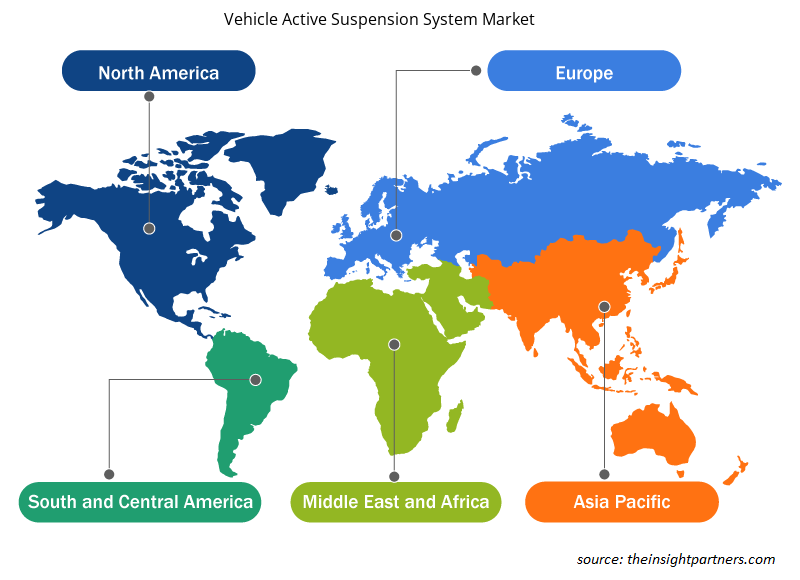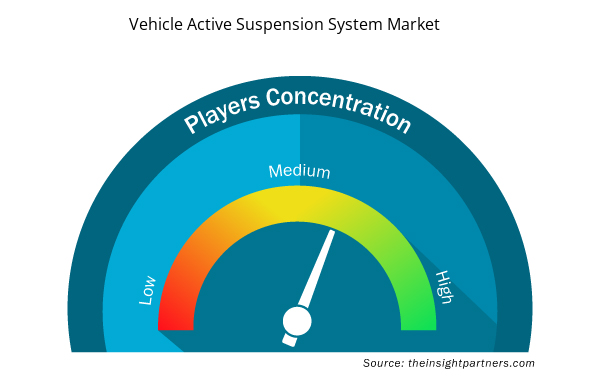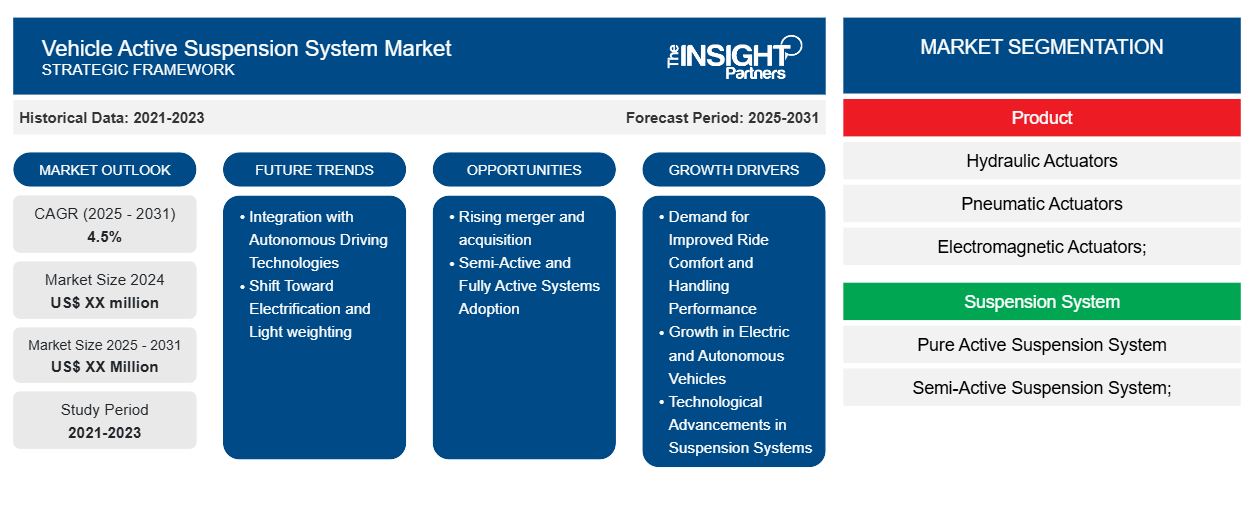Si prevede che il mercato dei sistemi di sospensioni attive dei veicoli registrerà un CAGR del 4,5% dal 2023 al 2031, con una dimensione di mercato in espansione da XX milioni di dollari nel 2023 a XX milioni di dollari entro il 2031.
Il mercato dei sistemi di sospensione attiva dei veicoli comprende l'analisi per prodotto (attuatori idraulici, attuatori pneumatici, attuatori elettromagnetici); sistema di sospensione (sistema di sospensione puramente attiva, sistema di sospensione semi-attiva); tipo di veicolo (veicolo passeggeri, veicolo commerciale, altri) e geografia (Nord America, Europa, Asia Pacifico, Medio Oriente e Africa e Sud e Centro America)
Scopo del rapporto
Il report Vehicle Active Suspension System Market di The Insight Partners mira a descrivere il panorama attuale e la crescita futura, i principali fattori trainanti, le sfide e le opportunità. Ciò fornirà spunti a vari stakeholder aziendali, come:
- Fornitori/produttori di tecnologia: per comprendere le dinamiche di mercato in evoluzione e conoscere le potenziali opportunità di crescita, consentendo loro di prendere decisioni strategiche informate.
- Investitori: condurre un'analisi completa delle tendenze in merito al tasso di crescita del mercato, alle proiezioni finanziarie del mercato e alle opportunità esistenti lungo la catena del valore.
- Enti di regolamentazione: regolamentano le politiche e le attività di controllo sul mercato allo scopo di ridurre al minimo gli abusi, preservare la fiducia degli investitori e sostenere l'integrità e la stabilità del mercato.
Segmentazione del mercato dei sistemi di sospensione attiva dei veicoli
Prodotto
- Attuatori idraulici
- Attuatori Pneumatici
- Attuatori elettromagnetici;
Sistema di sospensione
- Sistema di sospensione puramente attivo
- Sistema di sospensione semi-attivo;
Tipo di veicolo
- Veicolo passeggeri
- Veicolo commerciale
- Altri
Geografia
- America del Nord
- Europa
- Asia-Pacifico
- America del Sud e Centro
- Medio Oriente e Africa
Geografia
- America del Nord
- Europa
- Asia-Pacifico
- America del Sud e Centro
- Medio Oriente e Africa
Personalizza questo report in base alle tue esigenze
Riceverai la personalizzazione gratuita di qualsiasi report, comprese parti di questo report, o analisi a livello nazionale, pacchetto dati Excel, oltre a usufruire di grandi offerte e sconti per start-up e università
- Scopri le principali tendenze di mercato in questo rapporto.Questo campione GRATUITO includerà analisi di dati che spaziano dalle tendenze di mercato alle stime e alle previsioni.
Driver di crescita del mercato dei sistemi di sospensione attiva dei veicoli
- Richiesta di comfort di guida migliorato e prestazioni di maneggevolezza: i sistemi di sospensioni attive offrono un comfort di guida migliore tramite una regolazione continua delle sospensioni in base alle condizioni stradali, con conseguente guida più fluida e stabile. Poiché i consumatori richiedono esperienze di guida migliori, soprattutto nei veicoli di lusso e premium, le case automobilistiche stanno adottando sempre più sistemi di sospensioni attive per offrire prestazioni e comfort migliorati.
- Crescita nei veicoli elettrici e autonomi: i veicoli elettrici e i veicoli autonomi sono le tecnologie emergenti che stanno rendendo popolari i sistemi di sospensioni attive. I sistemi di sospensioni attive sono utili per i veicoli elettrici poiché hanno un baricentro più basso e sono più pesanti a causa dei pacchi batteria. Lo stesso vale per i veicoli autonomi, poiché richiedono tecnologie di sospensione avanzate per gestire il controllo preciso necessario per una navigazione sicura e fluida.
- Progressi tecnologici nei sistemi di sospensione: i progressi nella tecnologia dei sensori, negli attuatori e nei sistemi di controllo elettronico stanno rendendo i sistemi di sospensione attivi più convenienti ed efficienti. Con queste tecnologie, la sospensione può essere regolata in tempo reale in base alle condizioni stradali, alla velocità del veicolo e al comportamento di guida, il che dovrebbe migliorare la dinamica e la sicurezza del veicolo.
Tendenze future del mercato dei sistemi di sospensione attiva dei veicoli
- Integrazione con tecnologie di guida autonoma: le tecnologie di guida autonoma possono essere combinate con sistemi di sospensioni attive. Ciò può migliorare la stabilità del veicolo offrendo una migliore esperienza di guida durante manovre ad alta velocità o in un ambiente complesso. Man mano che la tecnologia autonoma continua a maturare, potrebbe esserci l'opportunità per i sistemi di sospensioni attive di svolgere un ruolo significativo nel garantire condizioni operative sicure e fluide nei veicoli completamente autonomi o semi-autonomi.
- Spostamento verso l'elettrificazione e la riduzione del peso: le case automobilistiche si stanno concentrando sulla riduzione del peso dei veicoli e sull'aumento dell'efficienza energetica. I sistemi di sospensioni attive stanno diventando più leggeri e più efficienti dal punto di vista energetico in questo senso. L'elettrificazione nei veicoli è una tendenza che sta spingendo lo sviluppo di sistemi di sospensioni attive più compatti ed efficienti, in particolare per i veicoli elettrici, dove l'efficienza energetica e il peso ridotto sono fondamentali per massimizzare l'autonomia.
Opportunità di mercato per i sistemi di sospensione attiva dei veicoli
- Fusioni e acquisizioni in aumento: attività di fusione e acquisizione in aumento da parte dei principali attori del mercato per sviluppare la crescita del mercato dei sistemi di sospensioni attive per veicoli avanzati durante il periodo di previsione. Ad esempio, a dicembre 2022, Magnaflow Group ha completato l'acquisizione di Camburg Engineering, azienda di sospensioni aftermarket per veicoli fuoristrada. L'azienda ha progettato parti correlate alle sospensioni per veicoli fuoristrada. A dicembre 2022, Fleetpride ha completato l'acquisizione di Keystone Spring Service. Keystone Spring Service offre sistemi di sospensioni per autoveicoli, componenti idraulici e parti per camion.
- Adozione di sistemi semi-attivi e completamente attivi: c'è uno spostamento verso sistemi di sospensioni semi-attivi e completamente attivi dai tradizionali sistemi di sospensioni passivi. I sistemi semi-attivi, che regolano la forza di smorzamento in base alle condizioni stradali, sono meno costosi dei sistemi completamente attivi ma forniscono miglioramenti sostanziali nella stabilità e nel comfort del veicolo. Tuttavia, i sistemi completamente attivi stanno diventando più popolari nei veicoli ad alte prestazioni per via del loro controllo e adattabilità superiori.
Approfondimenti regionali sul mercato dei sistemi di sospensione attiva dei veicoli
Le tendenze regionali e i fattori che influenzano il mercato dei sistemi di sospensione attiva dei veicoli durante il periodo di previsione sono stati ampiamente spiegati dagli analisti di Insight Partners. Questa sezione discute anche i segmenti e la geografia del mercato dei sistemi di sospensione attiva dei veicoli in Nord America, Europa, Asia Pacifico, Medio Oriente e Africa e America meridionale e centrale.

- Ottieni i dati specifici regionali per il mercato dei sistemi di sospensione attiva dei veicoli
Ambito del rapporto di mercato sui sistemi di sospensione attiva dei veicoli
| Attributo del report | Dettagli |
|---|---|
| Dimensioni del mercato nel 2023 | XX milioni di dollari USA |
| Dimensioni del mercato entro il 2031 | XX milioni di dollari USA |
| CAGR globale (2023-2031) | 4,5% |
| Dati storici | 2021-2022 |
| Periodo di previsione | 2024-2031 |
| Segmenti coperti | Per Prodotto
|
| Regioni e Paesi coperti | America del Nord
|
| Leader di mercato e profili aziendali chiave |
|
Densità degli attori del mercato del sistema di sospensione attiva dei veicoli: comprendere il suo impatto sulle dinamiche aziendali
Il mercato dei sistemi di sospensione attivi per veicoli sta crescendo rapidamente, spinto dalla crescente domanda degli utenti finali dovuta a fattori quali l'evoluzione delle preferenze dei consumatori, i progressi tecnologici e una maggiore consapevolezza dei vantaggi del prodotto. Con l'aumento della domanda, le aziende stanno ampliando le loro offerte, innovando per soddisfare le esigenze dei consumatori e capitalizzando sulle tendenze emergenti, il che alimenta ulteriormente la crescita del mercato.
La densità degli operatori di mercato si riferisce alla distribuzione di aziende o società che operano in un particolare mercato o settore. Indica quanti concorrenti (operatori di mercato) sono presenti in un dato spazio di mercato in relazione alle sue dimensioni o al valore di mercato totale.
Le principali aziende che operano nel mercato dei sistemi di sospensione attiva dei veicoli sono:
- Tenneco Inc
- Società Bose
- Continentale AG
- ZF-Friedrichshafen
- BorgWarner Inc
Disclaimer : le aziende elencate sopra non sono classificate secondo un ordine particolare.

- Ottieni la panoramica dei principali attori del mercato dei sistemi di sospensione attiva dei veicoli
Punti chiave di vendita
- Copertura completa: il rapporto copre in modo completo l'analisi di prodotti, servizi, tipologie e utenti finali del mercato dei sistemi di sospensione attiva dei veicoli, fornendo una panoramica olistica.
- Analisi degli esperti: il rapporto è compilato sulla base della conoscenza approfondita di esperti e analisti del settore.
- Informazioni aggiornate: il rapporto garantisce la pertinenza aziendale grazie alla copertura di informazioni recenti e tendenze nei dati.
- Opzioni di personalizzazione: questo report può essere personalizzato per soddisfare le esigenze specifiche del cliente e adattarsi in modo appropriato alle strategie aziendali.
Il rapporto di ricerca sul mercato dei sistemi di sospensione attivi per veicoli può, quindi, aiutare a guidare il percorso di decodifica e comprensione dello scenario del settore e delle prospettive di crescita. Sebbene possano esserci alcune preoccupazioni valide, i vantaggi complessivi di questo rapporto tendono a superare gli svantaggi.
- Analisi storica (2 anni), anno base, previsione (7 anni) con CAGR
- Analisi PEST e SWOT
- Valore/volume delle dimensioni del mercato - Globale, regionale, nazionale
- Industria e panorama competitivo
- Set di dati Excel


- Broth Market
- Emergency Department Information System (EDIS) Market
- Advanced Planning and Scheduling Software Market
- Space Situational Awareness (SSA) Market
- Oxy-fuel Combustion Technology Market
- Carbon Fiber Market
- Glycomics Market
- Fill Finish Manufacturing Market
- Investor ESG Software Market
- Cell Line Development Market

Report Coverage
Revenue forecast, Company Analysis, Industry landscape, Growth factors, and Trends

Segment Covered
This text is related
to segments covered.

Regional Scope
North America, Europe, Asia Pacific, Middle East & Africa, South & Central America

Country Scope
This text is related
to country scope.
Domande frequenti
The report can be delivered in PDF/PPT format; we can also share excel dataset based on the request.
Some of the customization options available based on the request are an additional 3-5 company profiles and country-specific analysis of 3-5 countries of your choice. Customizations are to be requested/discussed before making final order confirmation, as our team would review the same and check the feasibility.
High manufacturing costs of the vehicle active suspension system hinders the market growth.
The major players in the market includes Continental AG,ThyssenKrupp AG, Fox Factory Inc., KYB Corporation, Gabriel India Limited, BENTELER, Hendrickson L.L.C., Morelli Corporation, ZF Friedrichshafen AG, and Tenneco Inc.
The Vehicle Active Suspension System Market Size and Forecasts (2021 - 2031), Global and Regional Share, Trends, and Growth Opportunity Analysis Report Coverage: by Type (Hydraulic, Pneumatic); Design (Twin Tube, Mono Tube); Vehicle Type (Passenger Cars, Commercial Vehicles) , and Geography (North America, Europe, Asia Pacific, and South and Central America) is estimated to witness a CAGR of 4.5% from 2023 to 2031
The major factors driving the vehicle active suspension system market are: Demand for Improved Ride Comfort and Handling Performance, Growth in Electric and Autonomous Vehicles, and Technological Advancements in Suspension Systems
Trends and growth analysis reports related to Automotive and Transportation : READ MORE..
1. Tenneco Inc
2. Bose Corporation
3. Continental AG
4. ZF Friedrichshafen
5. BorgWarner Inc
6. thyssenkrupp AG
7. Daimler AG
8. Quanser Inc.
9. BeijingWest Industries
10. WABCO Vehicle Control Systems
The Insight Partners performs research in 4 major stages: Data Collection & Secondary Research, Primary Research, Data Analysis and Data Triangulation & Final Review.
- Data Collection and Secondary Research:
As a market research and consulting firm operating from a decade, we have published and advised several client across the globe. First step for any study will start with an assessment of currently available data and insights from existing reports. Further, historical and current market information is collected from Investor Presentations, Annual Reports, SEC Filings, etc., and other information related to company’s performance and market positioning are gathered from Paid Databases (Factiva, Hoovers, and Reuters) and various other publications available in public domain.
Several associations trade associates, technical forums, institutes, societies and organization are accessed to gain technical as well as market related insights through their publications such as research papers, blogs and press releases related to the studies are referred to get cues about the market. Further, white papers, journals, magazines, and other news articles published in last 3 years are scrutinized and analyzed to understand the current market trends.
- Primary Research:
The primarily interview analysis comprise of data obtained from industry participants interview and answers to survey questions gathered by in-house primary team.
For primary research, interviews are conducted with industry experts/CEOs/Marketing Managers/VPs/Subject Matter Experts from both demand and supply side to get a 360-degree view of the market. The primary team conducts several interviews based on the complexity of the markets to understand the various market trends and dynamics which makes research more credible and precise.
A typical research interview fulfils the following functions:
- Provides first-hand information on the market size, market trends, growth trends, competitive landscape, and outlook
- Validates and strengthens in-house secondary research findings
- Develops the analysis team’s expertise and market understanding
Primary research involves email interactions and telephone interviews for each market, category, segment, and sub-segment across geographies. The participants who typically take part in such a process include, but are not limited to:
- Industry participants: VPs, business development managers, market intelligence managers and national sales managers
- Outside experts: Valuation experts, research analysts and key opinion leaders specializing in the electronics and semiconductor industry.
Below is the breakup of our primary respondents by company, designation, and region:

Once we receive the confirmation from primary research sources or primary respondents, we finalize the base year market estimation and forecast the data as per the macroeconomic and microeconomic factors assessed during data collection.
- Data Analysis:
Once data is validated through both secondary as well as primary respondents, we finalize the market estimations by hypothesis formulation and factor analysis at regional and country level.
- Macro-Economic Factor Analysis:
We analyse macroeconomic indicators such the gross domestic product (GDP), increase in the demand for goods and services across industries, technological advancement, regional economic growth, governmental policies, the influence of COVID-19, PEST analysis, and other aspects. This analysis aids in setting benchmarks for various nations/regions and approximating market splits. Additionally, the general trend of the aforementioned components aid in determining the market's development possibilities.
- Country Level Data:
Various factors that are especially aligned to the country are taken into account to determine the market size for a certain area and country, including the presence of vendors, such as headquarters and offices, the country's GDP, demand patterns, and industry growth. To comprehend the market dynamics for the nation, a number of growth variables, inhibitors, application areas, and current market trends are researched. The aforementioned elements aid in determining the country's overall market's growth potential.
- Company Profile:
The “Table of Contents” is formulated by listing and analyzing more than 25 - 30 companies operating in the market ecosystem across geographies. However, we profile only 10 companies as a standard practice in our syndicate reports. These 10 companies comprise leading, emerging, and regional players. Nonetheless, our analysis is not restricted to the 10 listed companies, we also analyze other companies present in the market to develop a holistic view and understand the prevailing trends. The “Company Profiles” section in the report covers key facts, business description, products & services, financial information, SWOT analysis, and key developments. The financial information presented is extracted from the annual reports and official documents of the publicly listed companies. Upon collecting the information for the sections of respective companies, we verify them via various primary sources and then compile the data in respective company profiles. The company level information helps us in deriving the base number as well as in forecasting the market size.
- Developing Base Number:
Aggregation of sales statistics (2020-2022) and macro-economic factor, and other secondary and primary research insights are utilized to arrive at base number and related market shares for 2022. The data gaps are identified in this step and relevant market data is analyzed, collected from paid primary interviews or databases. On finalizing the base year market size, forecasts are developed on the basis of macro-economic, industry and market growth factors and company level analysis.
- Data Triangulation and Final Review:
The market findings and base year market size calculations are validated from supply as well as demand side. Demand side validations are based on macro-economic factor analysis and benchmarks for respective regions and countries. In case of supply side validations, revenues of major companies are estimated (in case not available) based on industry benchmark, approximate number of employees, product portfolio, and primary interviews revenues are gathered. Further revenue from target product/service segment is assessed to avoid overshooting of market statistics. In case of heavy deviations between supply and demand side values, all thes steps are repeated to achieve synchronization.
We follow an iterative model, wherein we share our research findings with Subject Matter Experts (SME’s) and Key Opinion Leaders (KOLs) until consensus view of the market is not formulated – this model negates any drastic deviation in the opinions of experts. Only validated and universally acceptable research findings are quoted in our reports.
We have important check points that we use to validate our research findings – which we call – data triangulation, where we validate the information, we generate from secondary sources with primary interviews and then we re-validate with our internal data bases and Subject matter experts. This comprehensive model enables us to deliver high quality, reliable data in shortest possible time.


 Ottieni un campione gratuito per questo repot
Ottieni un campione gratuito per questo repot